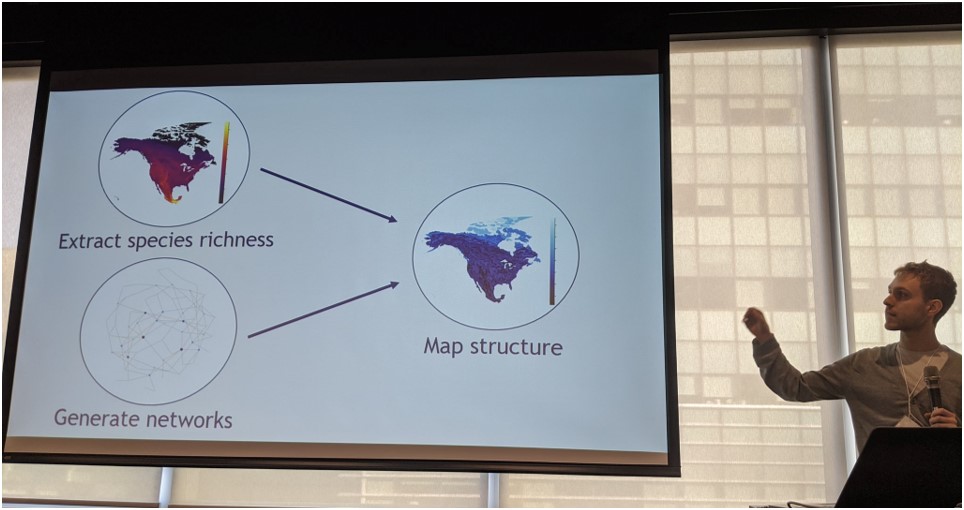Organized sessions
4. Biodiversity data for One Health: Integrating open data to address global health challenges
Groom, Q., Schwantes, C., Banville, F., Hoyos, J., Marceló-Díaz, D., Upham, N., and Poisot, T. (2025, October 23)
Living Data 2025, Bogota, Colombia
event, symposium, video
3. Connecting the dots: Bringing together scientists, policymakers, and practitioners to better implement biodiversity indicators
Arce Plata, M.I., Banville, F., Cruz Rodriguez, C., Dansereau, G., Forero‑Muñoz, N.R, & Poisot, T. (2024, October 24)
GEO BON pavilion, 2024 United Nations Biodiversity Conference (COP16), Cali, Colombia
event, side event, slides
2. Complexity matters: subjectivity as practice in contemporary biology
Leroux, E., Mélançon, V., Banville, F., Brémaud, J., Robitaille, F., & Gholamhosseini, M. (2023, March 16-17)
33rd Biology Symposium of the University of Montreal, Montreal, Qc, Canada
event

1. Space Oddity: Thinking about ecological networks across space
Dansereau, G., Banville, F., & Strydom, T. (2022, August 14-19)
ESA & CSEE Joint Meeting (Inspire session), Montreal, Qc, Canada
event, inspire session, Space Oddity
Contributed talks
13. Biodiversity monitoring and biosurveillance are fellow travellers
Banville, F. & Poisot, T. (2025, October 23)
Living Data 2025, Bogota, Colombia
event, video, slides
12. Monitoring biodiversity for human, animal, and environmental health
Banville, F., Carlson, C., Paz Velez, A., & Poisot, T. (2025, October 23)
Living Data 2025, Bogota, Colombia
event, video, slides
11. Monitoring biodiversity for human, animal, and environmental health
Banville, F., Carlson, C., Paz Velez, A., & Poisot, T. (2025, July 28)
GEO BON One Health Working Group Webinar: Towards biodiversity and health indicators, virtual
video, slides
10. Towards a maximum entropy theory of food webs
Banville, F., Gravel, D., & Poisot, T. (2025, July 6-9)
2025 Annual Conference of the Canadian Society for Ecology and Evolution, Sherbrooke, Qc, Canada
event, slides
9. Vers une théorie de l’entropie maximale des réseaux trophiques
Banville, F., Gravel, D., & Poisot, T. (2025, February 24-26)
2025 QCBS Symposium, Longueuil, Qc, Canada
event, slides
8. Quoi, quand et où manger ? À la découverte des interactions trophiques entre contraintes et incertitudes
Banville, F., Gravel, D., & Poisot, T. (2024, March 21-22)
34th Biology Symposium of the University of Montreal, Montreal, Qc, Canada
event, slides
7. Quoi, quand et où manger ? À la découverte des interactions trophiques entre contraintes et incertitudes
Banville, F., Gravel, D., & Poisot, T. (2024, February 19-21)
2024 QCBS Symposium, Montreal, Qc, Canada
event, slides
5. What constrains food webs? A maximum entropy model for predicting their structure with minimal biases
Banville, F., Gravel, D., & Poisot, T. (2022, August 14-19)
2022 Annual Meeting of the Ecological Society of America (ESA), Montreal, Qc, Canada
event, slides
4. Food webs of maximum entropy: A story of ecology and stochasticity
Banville, F., Gravel, D., & Poisot, T. (2022, March 25)
32nd Biology Symposium of the University of Montreal, Montreal, Qc, Canada
event, slides
3. Predicting networks of species interactions
Banville, F., Gravel, D., & Poisot, T. (2020, October 22)
IVADO Digital October 2020, virtual
event, slides, video
2. How to estimate network structure without interaction data
Banville, F., MacDonald, A., Gravel, D., & Poisot, T. (2020, February 19)
Extreme Climate Events Symposium 2020, Toronto, On, Canada
event, slides
1. How to estimate network structure without data
Banville, F., MacDonald, A., Gravel, D., & Poisot, T. (2019, December 18-20)
10th Annual QCBS Symposium, Montreal, Qc, Canada
event, slides

Lightning talks
4. Interactions entre espèces : une histoire d’écologie et de hasard
Banville, F., Gravel, D., & Poisot, T. (2022, March 29)
My IVADO research project in 180 seconds, Montreal, Qc, Canada
event, slides, video

3. Predicting food webs across space: First estimates of food-web structure derived from species richness
Banville, F., Gravel, D., & Poisot, T. (2021, October 28)
IVADO Digital October 2021, virtual
event, video
2. Trophic-METE: A parsimonious theory of food-web structure
Banville, F., Gravel, D. & Poisot, T. (2020, December 14-16)
11th Annual QCBS Symposium, virtual
event, slides
1. Analyzing species interaction networks in Julia
Banville, F., Vissault, S., Bélisle, Z., Hoebeke, L., Stock, M., Szefer, P., & Poisot, T. (2020, July 29-31)
Juliacon 2020, virtual
event, slides, video
Mangal.jl, EcologicalNetworks.jl, EcologicalNetworksPlots.jl
Mangal.jl, EcologicalNetworks.jl and EcologicalNetworksPlots.jl) to analyze and visualize species interaction networks in Julia. I’m still dreaming about Lisbon’s beaches to this day.Posters
3. Monitoring biodiversity for human, animal, and environmental health
Banville, F., Carlson, C., Paz Velez, A., and Poisot, T. (2025, July 6-9)
2025 Annual Conference of the Canadian Society for Ecology and Evolution, Sherbrooke, Qc, Canada.
event, poster
2. Given limited knowledge, what can we say about a food web’s properties?
Banville, F., Gravel, D. & Poisot, T. (2021, December 8-10)
12th Annual QCBS Symposium, virtual
event, poster
1. Trophic-METE: A parsimonious theory of food-web structure
Banville, F., Gravel, D. & Poisot, T. (2020, December 14-16)
11th Annual QCBS Symposium, virtual
event, poster


6. Comment les réseaux de prédateurs et de proies sont-ils structurés dans les milieux naturels?
Banville, F., Gravel, D., & Poisot, T. (2023, May 8-12)
90e congrès de l’ACFAS, Montreal, Qc, Canada
event, slides, video